

Variable Position Wireless Power Transmitter through Multiple Cooperative Flux Generators Joshua Schwannecke Advanced Technologies Group Fulton Innovation
Outline • Wireless Power System Requirements • Current Implementation • Improvements with Cooperative Flux Generators • Validation of Concept • Results • Conclusion
Introduction Fulton Innovation – 10+ years experience in Wireless Power – Technology development, licensing, and consulting on Wireless Power – Founding member of and Key Contributor to Wireless Power Consortium – Wholly owned subsidiary of Alticor, parent of Amway [1] “The Growth Potential for Wireless Power & Charging – 2011”, IMS Research, Aug. 2011 • Wireless Power expected to grow in consumer devices in next ten years – Wireless Power Consortium’s Qi TM standard addresses interoperability up to 5W
Wireless Power System Goals • More convenient than conventional “wired” power systems – Easy to initiate power transfer • Ideally works at any location – Readily available charging locations • Convenience realized through interoperability standard (Qi TM ) • Minimized power loss – Low loss in transmitter/receiver components – Minimal energy lost in unintended objects
Current Implementations in Qi TM • Concept: transmitter generates flux, receiver converts to usable B1 coil power, up to 5W • Many transmitters, two major themes – Array of many coils, used cooperatively or independently • Can be easier to locate charging area • Many coils can be expensive, complex to manufacture A1 coil – Single coil with positioning assistance • Simplest design • Additional requirements to locate charging area
Cooperative Flux Generators • Movable flux generating region • Coupling from transmitter to receiver sufficient – k>25% suitable for Qi TM power and communication • Multiple coils selected at given time • Can be extended in each direction arbitrarily long
Theory of Operation • Coils operated in tandem – Coils are coaxial on high permeability core – Coil current driven out of phase • Most flux in core cancels – Coils with current in opposite direction have a flux region between that can link to a receiver coil • Diamagnetic layer beneath array to reduce flux path
Finite Element Analysis • Outer two coils driven out of phase • High flux between transmitter coils • Less flux below diamagnetic layer • Lower flux in core • High coupling between transmitter coils, receiver coil
Operation in System • Two configurations – Internal Unused Pair (IUP) • Outer two coils of a group of three selected • Current in first coil inverse of current third coil – Adjacent Pair (AP) • Two adjacent coils along array selected • Current in first coil inverse of current in second coil • Pair of coils together are treated as primary coil array (PCA) in transformer • Automated control system tests each pair and selects pair with best coupling
Validation of Concept • Must be compatible with Qi TM – Must transfer guaranteed power to 4 reference receivers – Must have k > 0.25 with Reference Receiver A [2] to meet guaranteed power level • Validation procedure – Measure k at each position offset over each coil configuration – Superimpose coupling maps to understand total system area of sufficient coupling [2] System Description, Wireless Power Transfer Volume I: Low Power Part 1: Interface Definition, Wireless Power Consortium v.1.0.1, 2010.
Experimental Setup • WPC Reference Receiver A used as receiver (Rx) • PCA is 3 TX coils coaxially wound around 2.5mm NiZn ferrite tile (Fair-Rite TM Mtl 44) • TX coils 20 turns of 105/80 μ m litz • PCA dimensions: – 53mm x 53mm • Coil center spacing: – 18.67mm • 0.1mm copper layer below PCA coils
Coupling Mapping • Rx and PCA mounted to numerically controlled positioning system – Rx mounted 5mm above PCA – Offset +/- 20mm X, +/- 20mm Y, 1mm step • Coupling (k) calculated at each point – Primary (PCA) inductance, Secondary (Rx) inductance, and Mutual inductance between Rx and PCA measured successively • Mapping done for both IUP and AP PCA configurations
Coupling Map - AP • Peak k > 0.35 • Area of k > 0.25: – X: • 5mm to 23mm from left edge • +/- 9mm from line 6mm left of horizontal center – Y: • from 0mm to 40mm • +/-20mm from vertical center
Coupling Map - IUP • Peak k > 0.30 • Area of k > 0.25: – X: • +/- 7mm from horizontal center – Y: • from 0mm to 40mm • +/-20mm from vertical center
Coupling Map - Composite • Area of k > 0.25: – +/-15mm from horizontal center – +/- 20mm from vertical center • Additional Coils placed in horizontally would extend area indefinitely • Free positioning achieved over area 40mm wide, with arbitrary length
Conclusions & Next Steps • Arbitrarily long free positioning achieved • Compatibility with WPC Qi TM verified • Fewer coils used than in other array methods – Fewer power electronic components needed for control • Coaxially wound coils simpler to manufacture than other arrays • Multiple coils engaged in each direction could adapt to larger Rx coils • Could be extended to X & Y with orthogonal windings
Recommend
More recommend